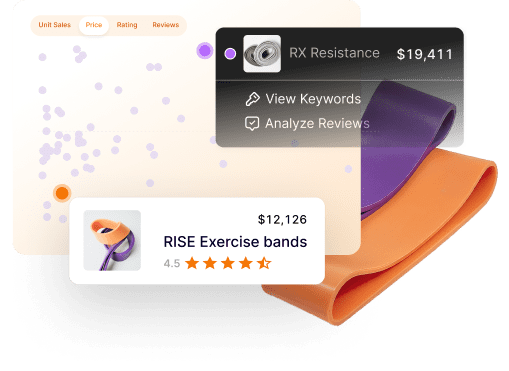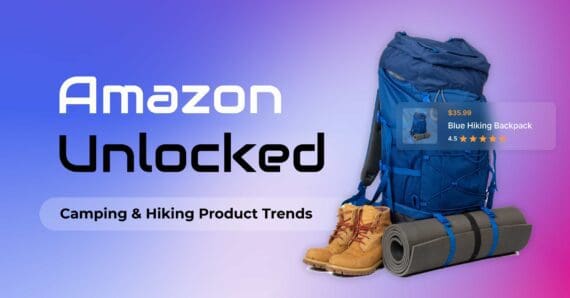We talk a lot about how to sell on Amazon FBA, which includes purchasing inventory upfront and shipping it to Amazon’s fulfillment centers, but did you know that there are ways to sell on Amazon without any inventory?
In this article, we’ll explore four ways you can make money on Amazon without having to purchase inventory.
Do you need inventory to sell on Amazon?
Generally, yes, you need inventory to sell on Amazon, as it operates primarily as a platform for selling physical goods. However, there are four main ways you can sell on Amazon or make money with Amazon without having to purchase upfront inventory.
What are those four ways?
- Dropshipping
- Print on Demand (POD)
- Amazon Kindle Direct Publishing (KDP)
- Amazon Associates Program (affiliate marketing)
If you don’t have a lot of money to invest in a private label product to sell on Amazon, which includes purchasing hundreds or thousands of units upfront, this is a great way to build up some capital or simply to earn extra income from Amazon.
How to sell products on Amazon without inventory: 4 methods
Now that you know the four ways, let’s dive a little deeper into each one so you can decide which method is right for you. We will also include links to our full in-depth articles on each of these methods.
1. Dropshipping on Amazon
Droppshipping, a favored approach to selling on Amazon, allows you to list products without holding any inventory yourself, aligning with the desire for low to no startup costs. When an order is placed, you purchase the product from a third party supplier or manufacturer and have it shipped directly to the customer.
So, you are selling a product without purchasing it upfront. You only buy the product and ship once your customer places an order.

While this method eliminates the need for upfront investment in inventory, Amazon has specific policies for dropshipping that require you to be the seller of record and ensure that the customer doesn’t receive any packing slips, invoices, or external identifiers from a third party.
Also, whatever you do, do not, dropship from another retailer such as Walmart. This is grounds for immediate termination of your seller account. Always follow Amazon’s terms to a T and you won’t have any problems dropshipping.
Only consider dropshipping on Amazon if you have a reliable supplier with fast shipping speeds, who also understands Amazon’s rules with dropshipping. Customers have become accustomed to 1 to 2 day shipping speeds on Amazon, so they’ll less likely order a product from someone with 1 to 2 week shipping times.
Amazon Dropshipping 2024 Guide: How to Dropship on Amazon
How do you find potential product niches for dropshipping on Amazon? Using Jungle Scout’s Opportunity Finder tool, sellers can find high-demand and low-competition products that they can potentially dropship.
Once you find a good product opportunity, your next step would be to find a reliable supplier for the product.
With Opportunity Finder, you can view more metrics about the niche you’re interested in, such as average units sold, search volume, and seasonality.

Use Jungle Scout Opportunity Finder to discover profitable niches for dropshipping.
2. Print on demand (POD)
Another effective strategy for inventory-free sales on Amazon involves using the print-on-demand model, specifically through Amazon Merch on Demand.

This service allows designers and sellers to create and sell custom-designed apparel, such as t-shirts and sweatshirts on Amazon, without buying the inventory upfront.
Sellers upload their designs to the platform, select the type of product, and set their price. Your shirts are then listed on Amazon, with Prime shipping.
When a customer orders one of these items, Amazon prints the design on the chosen product and ships it to the customer, and you, as the seller, earn a commission on each sale. Pretty cool, right?!
If you are a designer, have great t-shirt ideas, or a social media audience, Merch on Demand can be a unique opportunity for you to earn some extra money with Amazon.
The best part is, you don’t actually need to be a designer. You can hire low-cost designers from sites like Fiverr.com to create designs for you, and then you can upload them on Amazon.
What is Amazon Merch on Demand? A Step-by-Step Guide
How do you come up with ideas for merch you can offer on Amazon Merch on Demand? Using Jungle Scout’s Keyword Scout tool, you can discover popular and trending keywords. First, search for a topic that you are interested in, followed by ‘shirt’ and see if there is a significant search volume for that keyword.
In Keyword Scout, I searched for “classic car shirt,” and below were the results.

Keyword Scout shows me 163 keywords related to my search, giving me some more potential ideas for shirts we can create for Merch on Demand. As you can see, the keyword “car shirts” has a monthly search volume of 4,727 and has been trending upwards over the last 30 days.
This can be a good niche to get into for creating shirts. My next step would be to search for that keyword on Amazon and see what types of designs are the most popular.
Check out our complete guide to learn tips for successful print on demand on Amazon.
Use Keyword Scout to find highly searched keywords for your merch ideas.
3. Amazon Kindle Direct Publishing (KDP)
With Amazon Kindle Direct Publishing (KDP), writers and content creators can publish their works digitally or in print format, bypassing traditional inventory and publishing constraints.

With KDP, anyone can publish an ebook or paperback on Amazon, where it will be available digitally to the millions of Amazon shoppers who use Kindle readers.
If you offer a paperback version of your book, Amazon will print and ship the book to your customers when you receive a sale — again, all without purchasing inventory upfront. Everytime you sell a digital or physical book, you earn a royalty on each sale.
Check out one of our most popular videos on YouTube, teaching you how to sell medium content books on KDP!
Now, you don’t have to be an author to sell books using KDP. You can create what’s called low-medium content books, such as word searches, crossword puzzles, coloring books, children’s books, journals, and so on. The possibilities are endless!
If you want to start making money with Amazon KDP in 2024, check out our complete guide below.
Amazon Kindle Direct Publishing (KDP) 2024 Guide
4. Amazon Associates Program
Now the fourth and final way to sell on Amazon without inventory is with the Amazon Associates Program. This is when you earn money through affiliate marketing. Simply put, you are promoting other brands’ products in order to earn a commission.

If you are a blogger, content creator, or have a large social media following, promoting products through the Amazon Associates Program is a great way to earn money from your passion.
Let’s say you have a blog based on the outdoors. You can create an article comparing the top 5 camping tents, all linked to their respective Amazon listings, with your affiliate link.
When a reader clicks your link then buys, you earn a commission!
Same goes for YouTube, or other social media accounts. Add your affiliate links within the description of the video if you are speaking about a specific product on Amazon.
Want to learn more about maximizing profits with Amazon affiliate marketing? Here’s our complete guide to earning through Amazon Associates Program.
Benefits to these no-inventory selling methods
Selling on Amazon without holding inventory offers several compelling benefits that can attract entrepreneurs looking to minimize risks and costs associated with traditional selling on Amazon models such as private label, wholesale, or retail arbitrage. Here are some of the key advantages.
- Low to no startup costs. Without the need to purchase inventory upfront, the initial investment required to start a business is significantly reduced. This makes it easier for new entrepreneurs to earn money on Amazon without spending large amounts of capital.
- No inventory risk. Carrying inventory comes with the risk of unsold products, which can lead to large financial losses. Selling without inventory means you only order products from suppliers or use fulfillment services after a sale is made, eliminating the risk of overstock and unsold goods.
- No need for storage space. Storing inventory requires space, which can be costly. Even when using Fulfillment by Amazon, the storage costs can eat into your profits if you send too much inventory.
- Flexibility in product offering. Without inventory constraints, you can offer a wider variety of products and easily test new items in the market without significant upfront costs. This allows for quick adaptation to market trends and customer preferences.
- Scalability. Scaling a business that doesn’t require inventory is generally easier and more cost-effective. You can increase sales significantly without worrying about storage issues or large upfront investments in inventory.
- Global reach. Platforms like Amazon provide access to a vast global customer base — especially with Amazon KDP and Merch on Demand, where you can list your products on international Amazon marketplaces.
- Quick to market. Without the need to produce or purchase inventory in advance, you can quickly list and start selling products as soon as you identify market opportunities.
- Minimal financial risk. Selling on Amazon without inventory can be an attractive strategy for entrepreneurs looking to leverage Amazon’s reach and infrastructure while minimizing their own financial risk.
Will you try one of these methods?
If you have been interested in making money on Amazon but don’t have a lot of money to start with, try one of the four methods listed above. These are all profitable ways you earn some supplemental income or even replace your income.
Which one have you tried?
Leverage Jungle Scout's intelligence to find profitable products to sell on Amazon.
Brian Connolly is an Amazon seller, ecommerce expert, and writer for Jungle Scout. He lives in the New Jersey Shore area with his wife and cat. When he isn’t writing advice online for aspiring and experienced Amazon sellers for Jungle Scout, he spends his free time boating, fishing, and selling boating-themed items on his Amazon business.










